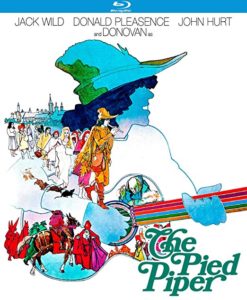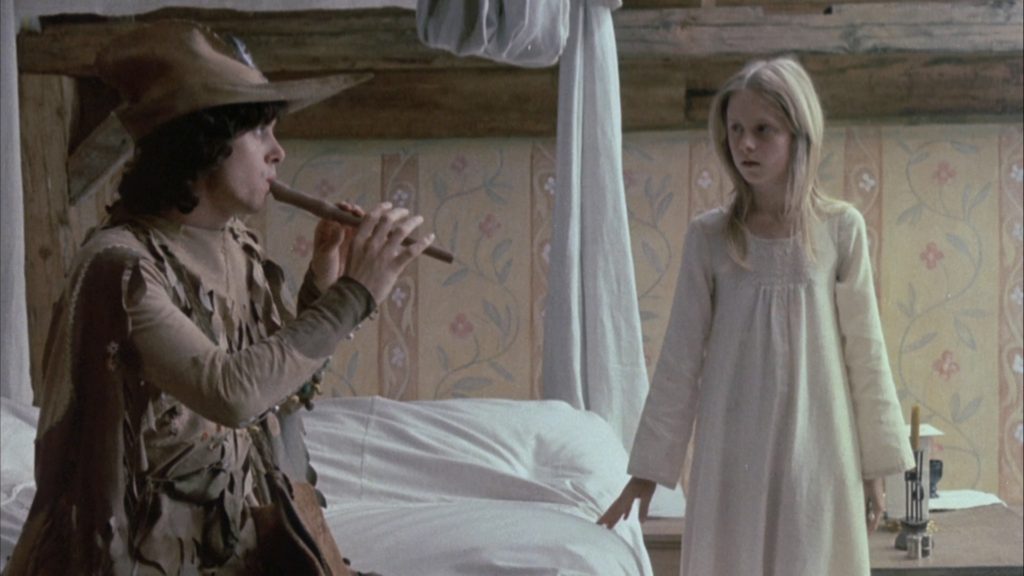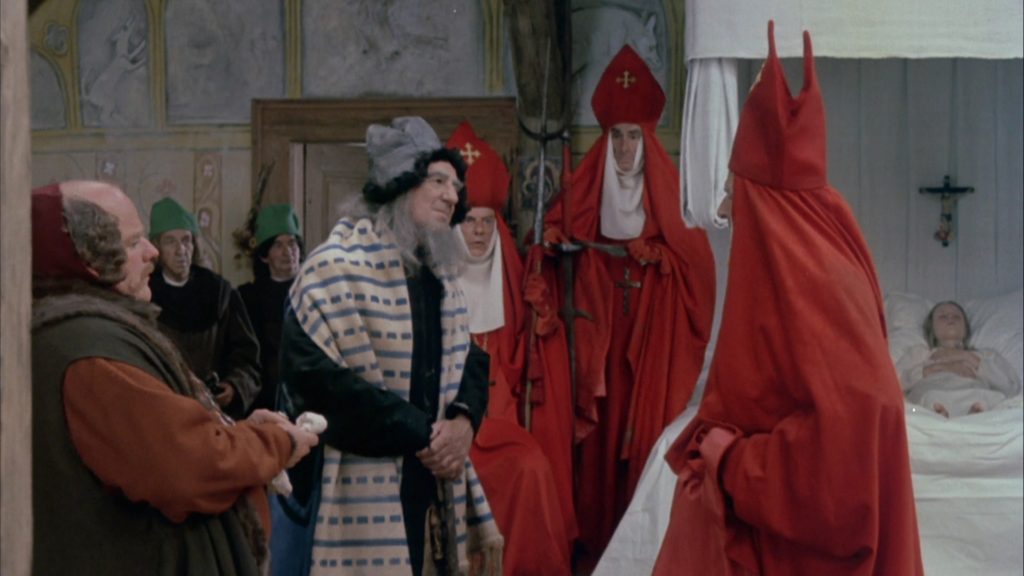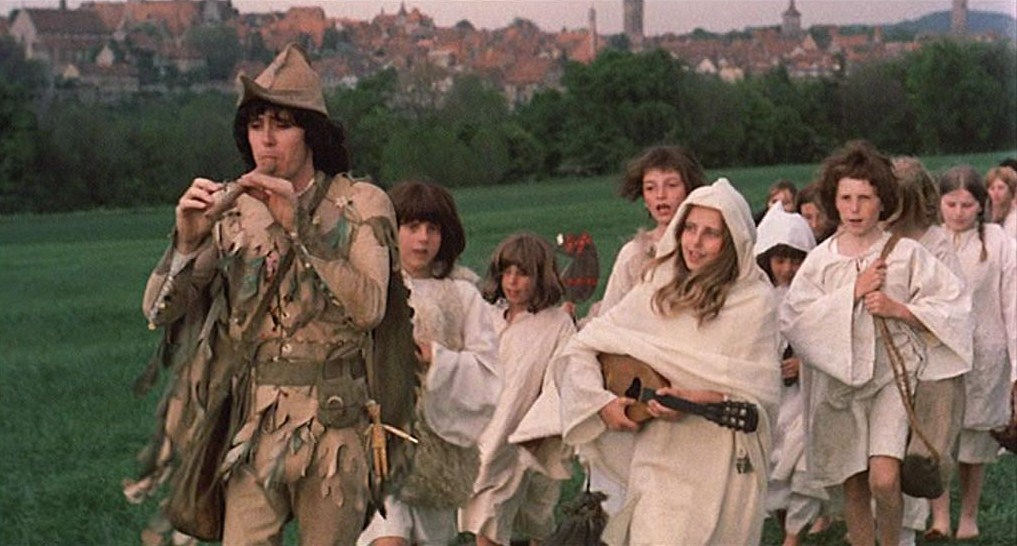Donovan Sings an Intriguing Song of Rats and People
DIRECTED BY JACQUES DEMY/1972
STREET DATE: APRIL 25, 2017/KINO LORBER STUDIO CLASSICS
 Much has changed in the world in 800 years, but one struggle that perpetuates like a shrill tune is the exhausting clash between science and religion. As far back as the time of the tale of the Pied Piper, this was the case. Did science as we know it exist at all? Unlikely, as the Dark Ages were ruled by fearful superstition – a current seized-upon by the church.
Much has changed in the world in 800 years, but one struggle that perpetuates like a shrill tune is the exhausting clash between science and religion. As far back as the time of the tale of the Pied Piper, this was the case. Did science as we know it exist at all? Unlikely, as the Dark Ages were ruled by fearful superstition – a current seized-upon by the church.
Today, the struggle plays out as large swaths of the faith community and the blue-collar working class rage against academia, intellectualism and booksmarts – and very much vice-versa. Both scientific advancements and religious proclamations are interpreted as salvos against “the other side” in a long perpetuated “culture war”. It’s a tragic struggle, considering that science and Christian faith needn’t be enemies at all.
Alas, on and on it goes. Whether it’s 1374, 1972 or 2017, the battle rages on. Times of tension, one and all. Here, it plays out in the film’s “A-story” as the local confectionist, a wise and assured old man, Melius (Michael Hordern) is persecuted by the diabolical local authorities (John Hurt and Donald Pleasance), themselves overloaded by glaringly bright red-robed agents of the Catholic Church. The king (Pleasance) is further impoverishing his subjects as he erects an ornate cathedral, first and foremost a monument to himself, alongside their dilapidated dwellings. Throughout the film, soul-weary locals stare up at ever-imposing wall-in-progress, leading them to question the point of their own faith. With a man-child ruler, only narcissism truly governs.
Whilst not skirting the reality of Dark Ages misery, nor avoiding the mythical framework that’s evolved around the Piper legend, Demy’s adaptation is nonetheless fairly loose, and peppered with a few mellow tunes, courtesy of Donovan, that are more at home in 1972 than the fourteenth century.
1972’s cinematic adaptation of the legend of The Pied Piper of Hamelin, interestingly featuring the singer Donovan in the title role, uniquely straddles the withering flower-child vibe of its own time while also rooted firmly into an aesthetic of grit, toil and tumult circa 1349.

If these kind of liberties can be taken with a portion of history in which 75,000,000 people died of the Black Plague and 150 children supposedly went missing, then it’s not too soon to quip that the Dark Ages really sucked.
Jacques Demy, the skilled French filmmaker of candy-colored musicals a decade prior (The Umbrellas of Cherbourg, The Young Girls of Rochefort) does what he can to grant a lighter view to this period’s most well known tale. Whilst not skirting the reality of Dark Ages misery, nor avoiding the mythical framework that’s evolved around the Piper legend, Demy’s adaptation is nonetheless fairly loose, and peppered with a few mellow tunes, courtesy of Donovan, that are more at home in 1972 than the fourteenth century. To be certain, many are played on a rainbow & happiness-decorated acoustic guitar.
Donovan’s turn as the title character fuels my theory that if one digs deeply enough, it can be verified that every rock star of yore turned up in a narrative film at some point. His Piper is a enigmatic man, ready and willing to regale those in need with a restorative twentieth century hippy ditty or some magical pipe playing. Drifting in and out of the film for long stretches, the Piper himself turns out to be a very glorified supporting role to top billed Jack Wild, John Hurt and Donald Pleasance.

In the greater cultural scheme of his day, Donovan, however close he got, was never anyone’s primary focus. He was great, and a star, but never a great star. With his unbalanced looks and hippie-dippy lyrics, the British pop/folk singer/songwriter made a musical splash in the mid-1960s. As a legitimate talent with peppy tunes to spare, it was a nicely earned bit of time in the spotlight. But even then, as this particular Sunshine Superman was burning up pop music charts, there was always Kryptonite around the corner.
Bob Dylan, comically confounded by the sudden onset of this guy Donovan during much of the documentary film Dont Look Back, takes the occasion of finally meeting with him to musically humiliate him.
Then, with the supernova onset of The Beatles dominating all things “British Invasion” at the time, Donovan had to settle for second fiddle. Even when it came to high profile celebrity pot busts in London, he was overshadowed by George Harrison. His film career, for the most part, begins and ends with The Pied Piper.

Twentieth century problems. The tale of Donovan’s career is well documented, as opposed to everything that went on in the Dark Ages, a time we can safely assume had bigger issues to focus on than which famous singer is most popular. (Although to be fair, so did the 1960s.)
A central treat of the film is Demy’s daft direction. He’s far from showy about his camera moves and shot choices, but they are all the more precise for that. It takes Demy a while to start employing close-ups in The Pied Piper, with the jarring exception of a quick shock-shot early in the film. His camera moves closer to the characters as we become more involved with their plights, tales and traumas. When the camera moves within a shot, it glides like magic.
The Pied Piper, quite obscure until this release by Kino Lorber for their never-uninteresting Studio Classics line (looking nicely like a good mid-level production of its day, but boasting zero bonus features to speak of – a missed opportunity), is no masterpiece. Nor is it a particularly upbeat film. If shown to children, they’re likely to be fascinated but also challenged by it. Quick historical exclamations (of the Middle Ages, the Black Plague, the ruling structure, etc.) may be in order. However, at only ninety-plus minutes, Demy’s The Pied Piper delivers as much contemporary food for thought as the title character delivers rats to their watery demise.
The images used in the review are present only as a reference to the film and are not meant to reflect the actual image quality of the Blu-ray.

